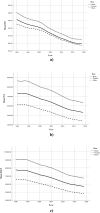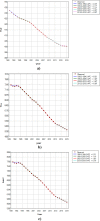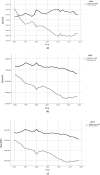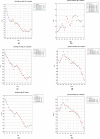Trend analysis of disability adjusted life years due to cardiovascular diseases: results from the global burden of disease study 2019
- PMID: 34187450
- PMCID: PMC8244206
- DOI: 10.1186/s12889-021-11348-w
Trend analysis of disability adjusted life years due to cardiovascular diseases: results from the global burden of disease study 2019
Abstract
Background: Cardiovascular diseases (CVDs) are the number one cause of global mortality representing about one third of all deaths across the world. The objective of the present study was to model the global trend in disability-adjusted life years (DALY) and its components due to CVD over the past three decades. We also aimed to evaluate the longitudinal relationship between CVD DALY and Human Development Index (HDI) in this period of time.
Methods: The age-standardized rates of years lost due to disability (YLD), years of life lost (YLL) and DALY were extracted for cardiovascular diseases from the Global Burden of Disease (GBD) Study 2019 in years 1990 to 2019. Additionally, the United Nations Development Programme (UNDP) database was used to retrieve HDI values for all world countries at the same period time. The trend analysis was performed using the joinpoint regression model.
Results: The obtained revealed a significant downward trend for DALY and its components with the average annual percent change of - 1.0, - 0.3 and - 1.1 per 100,000 population, respectively for DALY, YLD and YLL. We also found that countries with high/very high levels of HDI have remarkably experienced steeper declining slope of trend than those in lower levels of HDI over the study period.
Conclusions: Although the observed decreasing trend of CVD burden is a hopeful message for all world countries, the considerable gap in slope of trend between richer and poorer parts of the world is a serious alarm for health policy makers. Regarding this, there is an urgent need to put more efforts on implementing preventive programs, improving the level of patients' care and providing efficient treatment, especially in regions with lower levels of HDI.
Keywords: Cardiovascular diseases; Disability-adjusted life years; Human development index; Trend analysis.
Conflict of interest statement
The authors declare that they have no competing interests.
Figures




Similar articles
-
Global socioeconomic inequality in the burden of communicable and non-communicable diseases and injuries: an analysis on global burden of disease study 2019.BMC Public Health. 2021 Sep 28;21(1):1771. doi: 10.1186/s12889-021-11793-7. BMC Public Health. 2021. PMID: 34583668 Free PMC article.
-
Trend analysis of cardiovascular disease mortality, incidence, and mortality-to-incidence ratio: results from global burden of disease study 2017.BMC Public Health. 2021 Feb 25;21(1):401. doi: 10.1186/s12889-021-10429-0. BMC Public Health. 2021. PMID: 33632204 Free PMC article.
-
[The current status and trend of disease burden of neoplasms in 1990 and 2016 for Beijing people].Zhonghua Zhong Liu Za Zhi. 2021 Mar 23;43(3):351-356. doi: 10.3760/cma.j.cn112152-20190416-00239. Zhonghua Zhong Liu Za Zhi. 2021. PMID: 33752317 Chinese.
-
Global and regional burden of death and disability from peripheral artery disease: 21 world regions, 1990 to 2010.Glob Heart. 2014 Mar;9(1):145-158.e21. doi: 10.1016/j.gheart.2013.12.008. Glob Heart. 2014. PMID: 25432124 Review.
-
Methodological considerations in injury burden of disease studies across Europe: a systematic literature review.BMC Public Health. 2022 Aug 17;22(1):1564. doi: 10.1186/s12889-022-13925-z. BMC Public Health. 2022. PMID: 35978333 Free PMC article.
Cited by
-
Precision Medicine and the future of Cardiovascular Diseases: A Clinically Oriented Comprehensive Review.J Clin Med. 2023 Feb 23;12(5):1799. doi: 10.3390/jcm12051799. J Clin Med. 2023. PMID: 36902588 Free PMC article. Review.
-
Organic Nanoparticles in Progressing Cardiovascular Disease Treatment and Diagnosis.Polymers (Basel). 2024 May 16;16(10):1421. doi: 10.3390/polym16101421. Polymers (Basel). 2024. PMID: 38794614 Free PMC article. Review.
-
Cost of illness of Heart Valve Diseases (HVDs): A real-world analysis in Italy.Glob Reg Health Technol Assess. 2025 Feb 19;12:34-42. doi: 10.33393/grhta.2025.3243. eCollection 2025 Jan-Dec. Glob Reg Health Technol Assess. 2025. PMID: 39996092 Free PMC article.
-
Spatiotemporal effects of urban micro-scale built environment on cardiovascular diseases.Sci Rep. 2025 May 17;15(1):17193. doi: 10.1038/s41598-025-02603-w. Sci Rep. 2025. PMID: 40382476 Free PMC article.
-
Graves' disease, its treatments, and the risk of atrial fibrillation: A Korean population-based study.Front Endocrinol (Lausanne). 2022 Nov 1;13:1032764. doi: 10.3389/fendo.2022.1032764. eCollection 2022. Front Endocrinol (Lausanne). 2022. PMID: 36387909 Free PMC article.
References
-
- Naghavi M, Wang H, Lozano R, Davis A, Liang X, Zhou M, et al. GBD 2013 mortality and causes of death collaborators global, regional, and national age–sex specific all-cause and cause-specific mortality for 240 causes of death, 1990–2013: a systematic analysis for the global burden of disease study 2013. Lancet. 2015;385(9963):117–171. doi: 10.1016/S0140-6736(14)61682-2. - DOI - PMC - PubMed
-
- WHO Global Action Plan for the prevention and control of noncommunicable diseases 2013–2020. Geneva: World Health Organization 2013. https://apps.who.int/gb/ebwha/pdf_files/WHA66/A66_R10-en.pdf?ua=1. Accessed 15 Apr 2021.
MeSH terms
LinkOut - more resources
Full Text Sources
Medical
Miscellaneous

